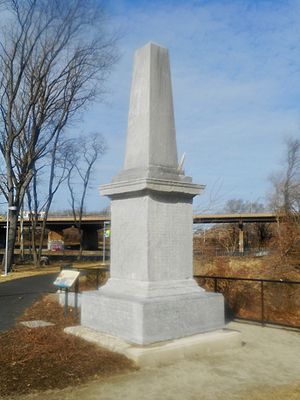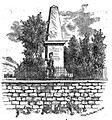Newkirk Viaduct Monument facts for kids

2018 photo
|
|
| Coordinates | 39°56′24″N 75°12′23″W / 39.9400°N 75.2063°W |
|---|---|
| Location | West Philadelphia |
| Designer | Thomas Ustick Walter |
| Type | obelisk |
| Material | white marble |
| Width | 5 feet (1.5 m) |
| Height | 14 feet (4.3 m) |
| Completion date | 1839 |
| Dedicated to | Matthew Newkirk |
| Moved from original location sometime after 1927. Moved to current location in 2016. | |
The Newkirk Viaduct Monument is a 15-foot (4.6 m) tall, white marble obelisk in West Philadelphia, Pennsylvania. It was put up in 1839 to celebrate the finishing of the Newkirk Viaduct. This was the first permanent railroad bridge over the Schuylkill River. The monument has the names of 51 people who helped build the railroad, along with other important details.
Thomas Ustick Walter, who later designed the dome of the U.S. Capitol, created the monument. The Philadelphia, Wilmington and Baltimore Railroad built it to mark the completion of their bridge across the Schuylkill River. This bridge was part of the first railroad line going south from Philadelphia.
The monument has been moved several times. It first sat about 700 feet (210 m) from the river. Between 1927 and 1930, it moved further inland. In 2016, it was moved again to its current spot. This new location is about 100 feet (30 m) from the river's edge. It is now at the north end of the Bartram's Mile section of the Schuylkill River Trail.
Contents
Monument's Story: A Journey Through Time
This monument celebrates the completion of the Newkirk Viaduct in 1838. This bridge was also known as the Gray's Ferry Bridge. It crossed the Schuylkill River. The bridge helped create the first direct train route between Philadelphia and Baltimore, Maryland. This new rail line followed a path similar to the old King's Highway.
Why Was the Monument Built?
On August 14, 1838, the railroad company decided to name the bridge after its president, Matthew Newkirk. He was an important business and community leader in Philadelphia. They also decided to build a monument at the bridge's west end. Earlier that year, Newkirk received a special silver plate for helping four railroad companies merge. This merger created the Philadelphia-Baltimore line.
Who Designed This Special Monument?
Thomas Ustick Walter designed the white marble monument. He later became famous for designing the dome of the U.S. Capitol. The monument is made of seven carved stone pieces. They are held together by their own weight and friction, without metal pins. The top part, an obelisk, weighs about 6,000 pounds (2,700 kg). The base and other pieces weigh around 12,000 pounds (5,400 kg). The monument lists the names of 51 men. These include leaders from the four railroad companies and workers who built the bridge and rail line.
Where Was It First Located?
The monument was first placed near the western side of the bridge. It was surrounded by a low iron fence. An old description from 1895 says it was on a high bank. This spot was where two railroad lines met, just below the west end of the Gray's Ferry Bridge. It was about 700 feet (210 m) from the Schuylkill River.
Over time, the monument became less known. An article from 1896 mentioned that it was often targeted by vandals. In 1900, another newspaper said it was "scarcely ever seen" because it was hard to reach and hidden by trees.
Moving the Monument: The First Time
Around 1926, the Pennsylvania Railroad planned to move the monument. They needed more space for their train yard. The monument was moved sometime between May 1927 and September 1930. It went to the site of a train station that no longer exists. For the next 80 years, the monument was mostly forgotten and in disrepair. However, train passengers on Amtrak and SEPTA Regional Rail could still see it.
Moving the Monument: The Second Time
In 2013, people became interested in the Newkirk Monument again. Articles suggested moving it to a more visible place. Many groups worked together to make this happen. These included Amtrak, Philadelphia Parks & Recreation, and other organizations. On November 17–18, 2016, the monument was moved to a new concrete pad. This new spot is along the "Bartram's Mile" section of the Schuylkill River Trail.
What Does the Monument Say?
The monument has inscriptions on all four sides of its obelisk and base. These words tell us about the railroad companies and the people involved.
|
|
|
|
|
| Obelisk | |||
|---|---|---|---|
|
PHILADELPHIA WILMINGTON AND BALTIMORE RAILROAD COMPANY
President Vice President Directors Secretary, ALLAN THOMSON. AUBRY H. SMITH, Ass't. |
BALTIMORE AND PORT DEPOSIT RAILROAD COMPANY President Directors Secretary and Treasurer, Engineer, Assistant Engineer, |
DELAWARE AND MARYLAND RAILROAD COMPANY. President, Directors: Engineer, Assistant Engineer, |
WILMINGTON AND SUSQUEHANNA RAILROAD COMPANY. President, Directors Secretary, Treasurer, Engineer, Assistant Engineer, |
| Base | |||
|
THE PHILADELPHIA WILMINGTON AND BALTIMORE RAILROAD COMPANY Formed A.D. 1838 by the Union |
Railroad Contractors: Superintendents: |
NEWKIRK VIADUCT Samuel H. Kneass, Engineer. |
NEWKIRK VIADUCT Commenced July 4, 1837. |
Images for kids
See also
 In Spanish: Monumento del viaducto de Newkirk para niños
In Spanish: Monumento del viaducto de Newkirk para niños




